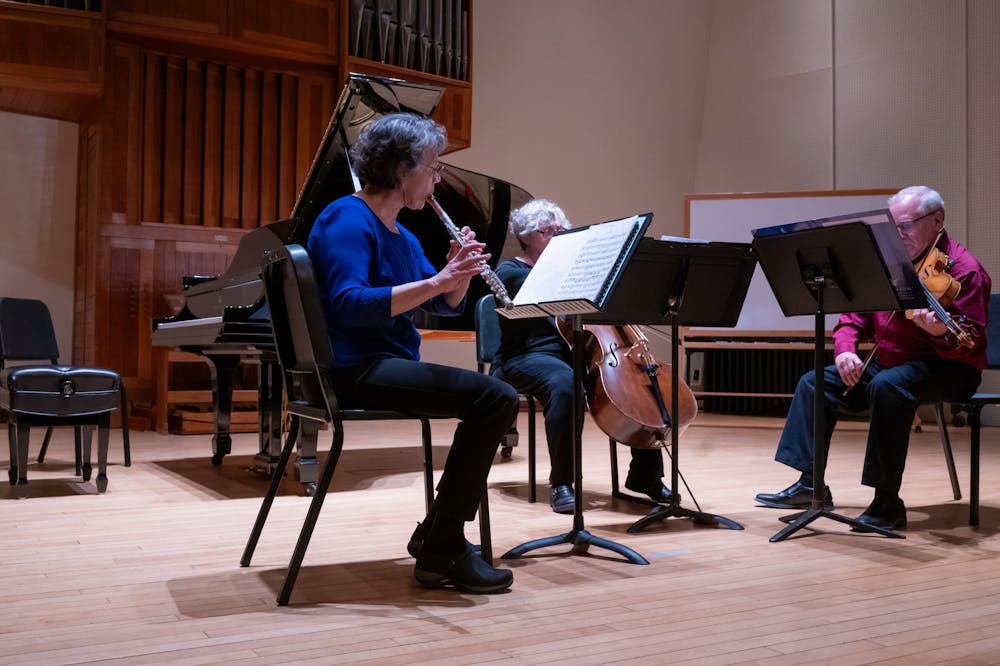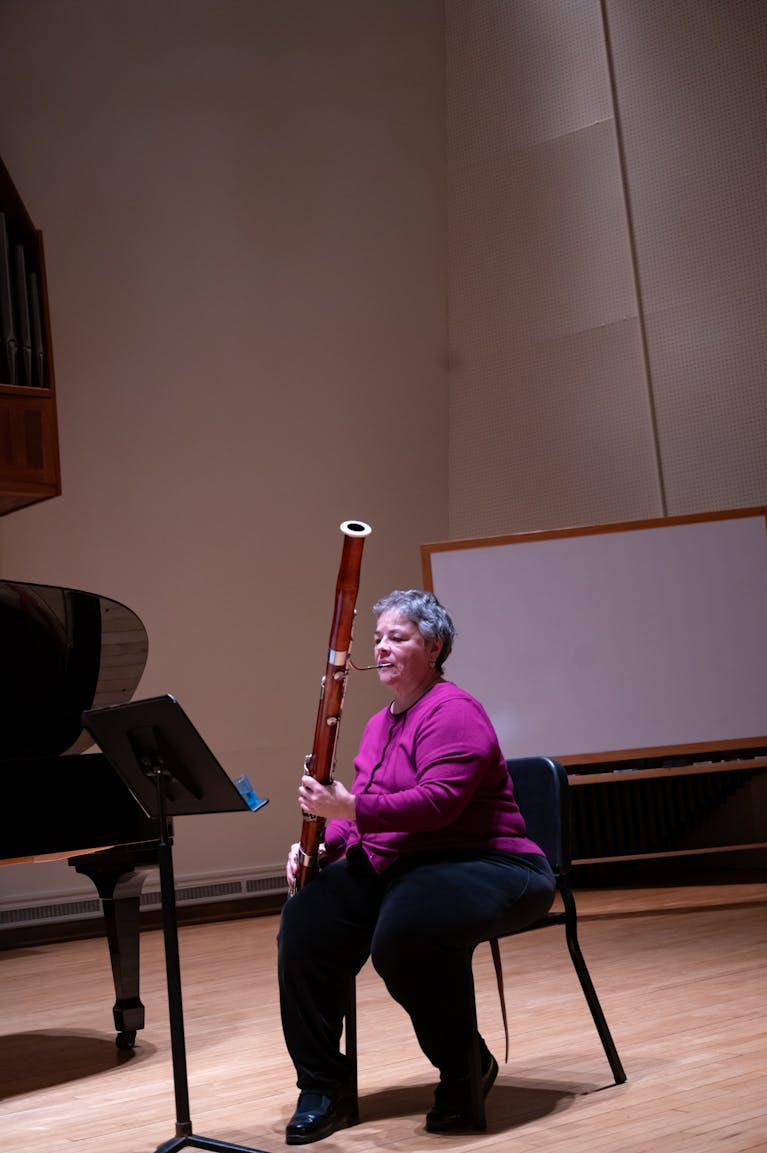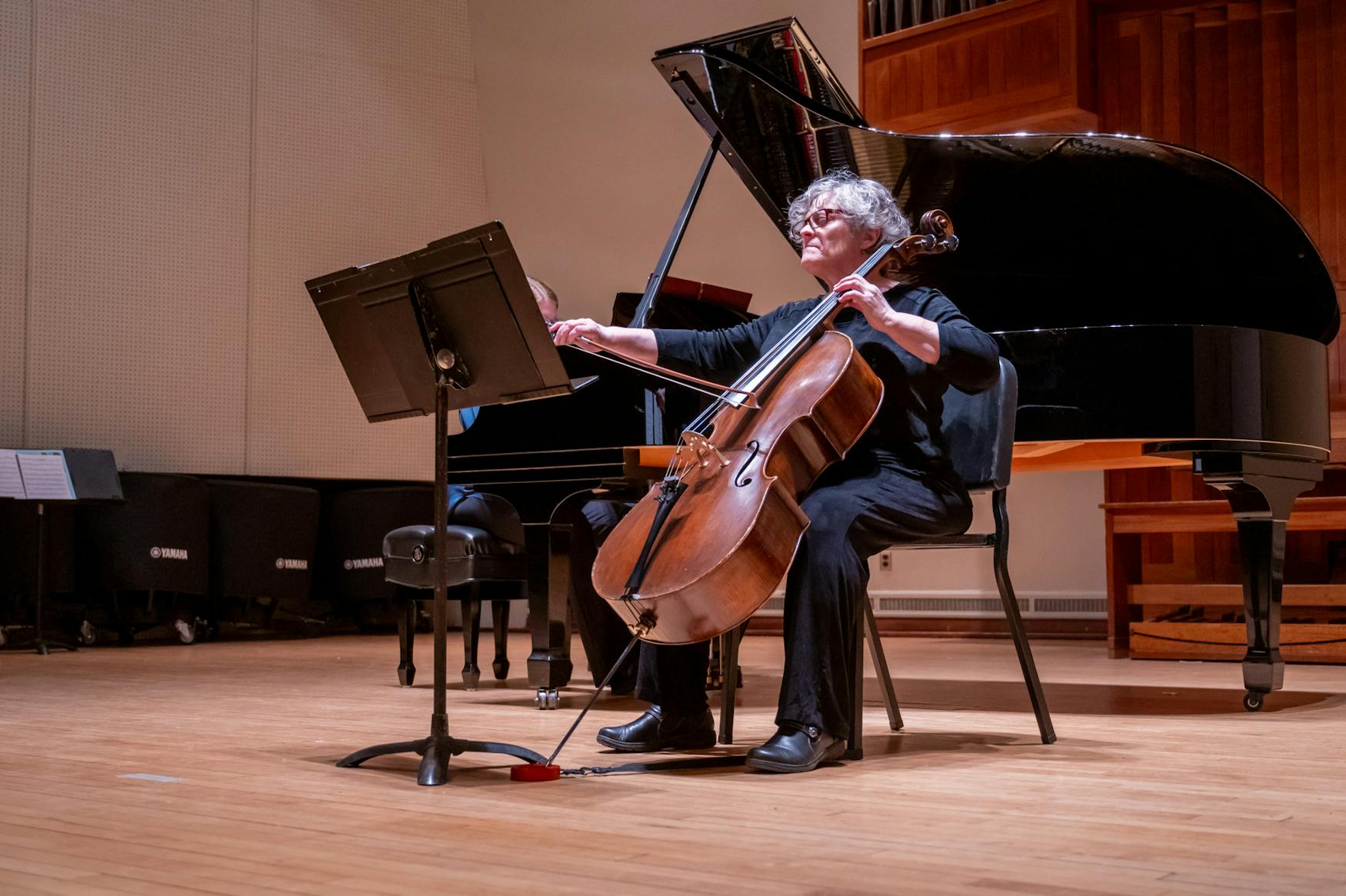Sounds of Brandeis: The Kaleidoscope Concert
The Brandeis Concert Series is an incredible and rare opportunity to see free live music every weekend in the Slosberg Recital Hall. The series includes both student and faculty performances with a diverse line-up including jazz, chamber singing, a Ghanaian drum and dance ensemble and never-before-seen pieces that were composed by Brandeis students, faculty and alumni. Upcoming performances include Hypercube, a Brandeis original composition, on Mar. 2 and Evan Hirsch’s piano recital on Mar. 8, with various other performances on Mar. 16, 17, 23 and 24.
I had the pleasure of sitting down with two members of the Kaleidoscope Chamber Ensemble who performed on Feb. 11 to learn more about Kaleidoscope and music at Brandeis. Kaleidoscope’s flutist, Jill Dreeben, is a faculty member who teaches Brandeis students flute and body mapping. Body mapping is the conscious correction and refinement of one’s body map. It helps musicians play without injuries by understanding their own anatomy and how best to move their bodies during practices and performances. Jill spoke about what she’s learned from her students in her teaching here at Brandeis, “Everybody learns differently, so I have to find ways to get into what they need. I try to think about it the way they think about it so I’m always learning new ways of figuring out how to reach somebody and I really like that. I feel like in teaching you have this relationship with your student where you want to know as much about them as you can so that you can help them. You want to find what the easiest way is for them to learn. For my body mapping class, I have them write journals so I can really get a sense of how they’re thinking about it and I can find a way to respond and give them feedback in the way that will direct the way they want to learn the next thing. It’s very important to know how students think and how they respond. You’re trying to figure them out as much as they’re trying to figure themselves out.”

TRIO OF MUSICIANS: The Kaleidoscope Chamber Ensemble performs a piece with Jill Dreeben on flute, Sandi-Jo Malmon on cellist and Dani Rimoni on viola.
Kaleidoscope’s cellist and one of their founding members, Sandi-Jo Malmon, is a Librarian for Collection Development at Harvard’s Loeb Music Library. Malmon, along with a handful of other musicians, created Kaleidoscope in 1991. Over the years, the Ensemble has added and subtracted instruments. While they started out as a string trio with a flutist and a pianist, they’ve grown to include everyone from a clarinetist to a bassoonist. It is from this diverse array of instruments that the name of the Ensemble was born. Malmon recounted, “We thought of all kinds of names and then we said, ‘Hey, it’s kind of a kaleidoscope.’ It was very simple.” To Malmon, the beauty of the Ensemble’s name is that “it gives us an enormous amount of flexibility.”
Dreeben shared the same sentiment when I asked her about what differentiates the Kaleidoscope Chamber Ensemble from others. She explained,“This group is called Kaleidoscope, which means colors, so we do a lot of combinations of pieces with different combinations of instruments.” The Ensemble rarely does a performance consisting of only one type of piece. They blend modern and earlier music, along with composers of different backgrounds, to truly create a colorful and dynamic performance.
Malmon broke down the process of creating these performance programs. To start, “We have brainstorming meetings, and we talk about the pieces we’d like to play. We have a list of those and then we look to see what might be a good combination of pieces.” From there, the Ensemble pays attention to how they can reinvent the conventional musical canon. Malmon shared, “The standard canon used to be Beethoven, Mozart and Haydn, but now the canon is changing. All of the language is changing in the same way that at the beginning of the 20th century the language of music and art and writing and literature was so diverse and now it’s becoming so as well.”
The first piece from composer Eugene Bozza, “Contrastes I pour Flute et Bassoon,” included eight parts that came together to form a dreamy, woodland-like sound. Throughout all eight parts the musicians, Tracy McGinnis on bassoon and Dreeben on flute, would play with contrasting melodies that would come together in beautiful harmony as the deep hum of the bassoon complimented the airiness of the flute. The first part, Andante, felt like a walk in the woods, overhearing a light and airy conversation between friends. The duo moved on to the second part, Moderato, a lower piece ending in an unresolved air of mystery. The fourth and seventh parts, both Allegretto, brought back childhood adventures with their bright and lively energies, with the seventh part’s fast pace and sudden end feeling like a euphoric run ending with a fall in the grass.

The next piece, “American Canvas for flute, cello and piano” by contemporary composer Jennifer Higdon, includes three sections inspired by different artists. The first section, O’Keefe was prefaced with a quote from Georgia O’Keefe, “Nobody sees a flower — really — it is so small it takes time — we haven’t time — and to see takes time, like to have a friend takes time.” The low tones of the cello played by Malmon with the harmonies and melodies of the piano and flute were reminiscent of O’Keefe’s blossoming flowers. A cello solo then took the listeners to the desert scenes of New Mexico before an explosion of controlled chaos brought the flowers back to life. A piano solo took us into O’Keeffe’s dark scenes of New York’s nightlife with a bright moon illuminating the environment. This musical ekphrasis revealed to us the great power found in female artistry and displayed flowers in a new light — not as delicate ornaments, but as explosions of color.
The following section, named after Jackson Pollock, stayed true to the artist’s nature with its splattering of notes mimicking his famous paint splatters. This section was a journey the musicians took their audience on, similar to how Pollock would lay his canvas down and take pictures of his artistic process. The next piece, inspired by Andrew Wyeth, included the pianist Elizabeth Skavish plucking at the internal strings of the piano, a technique I had never seen before that created a sound similar to the plucked strings of a viola. The plucked, bouncy sounds of the piano and cello coincided beautifully with the airy, melodious flute. The section provided a wonderful soundtrack to Wyeth’s midwestern paintings with sections evocative of wind blowing through grass and running through corn fields.
After “American Canvas” evoked so many images in the listener’s mind, we were given a calming rest and reset with Arvo Pärt’s “Spiegel im Spiegel” performed by the piano and cello. Before the piece began, the audience was invited to take this time to meditate and sit in stillness and peace. True to their invitation, the soft, comforting piano and the crying vibrato of the cello felt like a warm hug after a long period of homesickness. The performance built up emotions, but always resolved them, bringing a sense of healing that would be impossible outside of live music. This piece, and the genuine, wholesome comfort and hope it provided, stayed with me and helped relieve my stress for the rest of that day.
I asked Malmon about their motivation for adding this meditation to their program. According to her, in the past they have played around with accompanying a singular instrument with the piano. The Ensemble loved the tranquility that resulted from this combination, especially in contrast with the more lively music often included in their programs. As such, they decided to try something similar in their recent performance. Malmon explained the reasoning behind specifically choosing a piece by the Estonian composer, Arvo Pärt. She stated, “The musical language he uses is called tintinnabuli. He never followed a school of composition, so it’s just interesting to work on something that is really different. And I probably would venture to say that he’s sort of minimalist, I don’t know if he would like that interpretation of it. I think it does lend itself to meditation and a different way of self-expression.”
After a fifteen-minute intermission, the viola, played by Dani Rimoni, entered the ensemble with the piece “Drobnosti for flute, viola and cello Op. 75a” by composer Antonin Dvorak. The starting Cavatina held a dramatic tone with the viola and cello that was balanced by the flute’s lightness. The following Capriccio was instantly more active, keeping listeners guessing with the jumping strings and alternating roles with a bouncy melody and smooth backing. The final Romance, true to its name, was reminiscent of a smooth dance in a castle ball.
The final “Trio for Oboe, Bassoon and Piano” from Andre Previn brought the oboe, played by Charlyn Bethell, into the mix. The three parts, “Lively,” “Slow,” and “Jaunty” all contained jazz influences that brought to mind the soundtracks of Studio Ghibli films like “My Neighbor Totoro” or “Spirited Away.” “Lively” offered an electric “La La Land” type of intro with the piano jumping along to the smooth melodies of the oboe and bassoon before ending in a conversational game with the three instruments. This trio was by far my favorite combination of instruments in a live performance and a combination absolutely worth hearing. “Slow” was nostalgic and down-to-earth with some mesmerizing oboe sections. Finally, “Jaunty” acted as the perfect closer, calling to mind a fairy tale battle scene with toy soldiers commanded by the kings of a distant playground where magic still prevails. The battle built up and up before ending in an effortlessly playful trill of the piano.
The program interestingly didn’t include any music from the canon, so I asked Malmon if the ensemble feels the need to share canon composers or if they prefer less famous ones. Malmon responded, “The thing as a performer that’s always a challenge is what’s good for the audience in terms of listening and what is good for the performer. And sometimes they’re the same and sometimes they’re not.” In their performances, the Ensemble recognizes that there’s a need to recognize and honor the audience they’re playing for. Just as they believe in varying instruments to create a unique sound, Kaleidoscope blends musical styles and periods to create a unique experience for each audience.
As an active part of Brandeis’ music department, I asked Dreeben how she felt the Brandeis administration could better support our music program. It came down to a matter of highlighting and advertising faculty performances, as well as setting aside more funding for faculty that do concerts. According to Dreeben, “For the musicians that don’t teach classes and just teach their instruments, if we want to do something, we have to set it up ourselves and the school doesn’t pay for it.” Honoring the talent of our music faculty and creating spaces for students to enjoy live music on campus are both incredibly important. The faculty wants to perform, however, as Dreeben noted, their concerts are not a financial priority for the University.
Dreeben’s final statement to Brandeis students regarding what the music department has to offer is “When I was studying music and my teacher played in a concert, I would change my life to go see my teacher playing in that concert. I don’t think students do that now and I know it’s because they’re drowning and everything else, but live music is an experience that’s completely different from any other musical experience.” Ultimately, the connection fostered in spaces of live music is invaluable and absolutely worth taking advantage of.
I’d like to thank the Kaleidoscope Chamber Ensemble for both their incredible performances and their insightful responses. This performance was the perfect way to escape from the typical college stress in a way that excites, stimulates and motivates me rather than tires and bores me. These free shows are a true gift, so I urge my peers to make the most of it and experience the unique joys of live performance during their time at Brandeis.



Please note All comments are eligible for publication in The Justice.